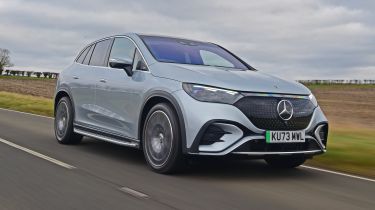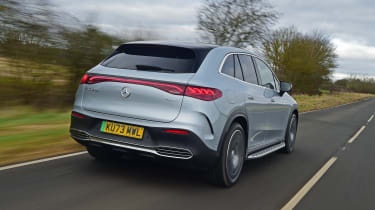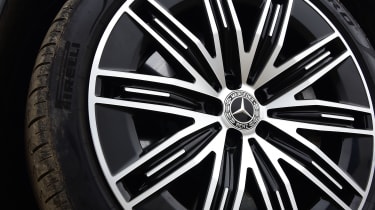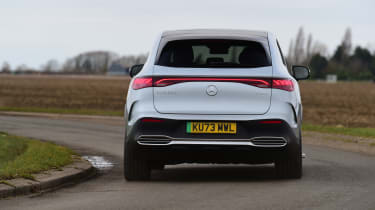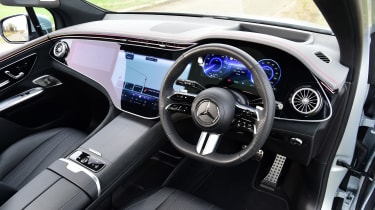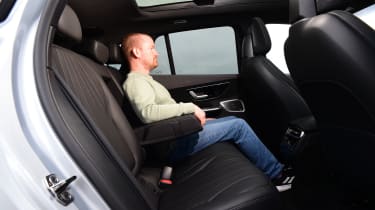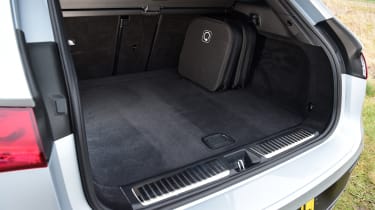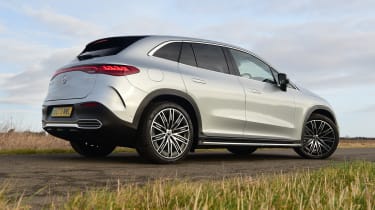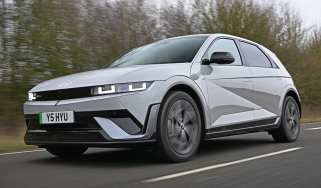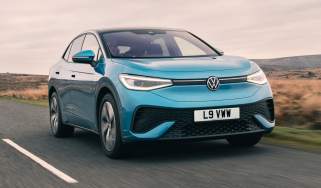Mercedes EQE SUV review – tech-filled but pricey electric SUV
“The Mercedes EQE boasts impressive technology, range and interior space, but it’s also expensive and misses the mark in other areas”
Pros
- Long range
- Stunning infotainment
- Practical interior
Cons
- Expensive
- Some cheap interior bits
- No ‘frunk’ storage
Verdict - Is the Mercedes EQE SUV a good car?
As Mercedes’ product line-up diverges into two strands of more traditional models and futuristic, all-electric ‘EQ’ cars, the Mercedes EQE SUV finds itself facing off against rivals like the BMW iX – a new breed of all-electric luxury SUVs. Costing from around £90k, the EQE SUV isn’t cheap but for the money, you’ll get a large five-seat model with a 300-plus mile range and impressive refinement. Its interior also looks suitably sci-fi, although, in the pursuit of huge screens and cutting-edge tech, some less obvious areas of cabin quality appear to have been neglected.
Mercedes EQE SUV specs, models and alternatives
Mercedes is fully committed to pushing its model range upmarket and transforming its lineup to fully electric models. It has already launched a number of zero emission SUVs, and the EQE SUV slots in between the smaller Mercedes EQC and luxurious EQS SUV. It has a lofty starting price of just over £90,000 – around £15,000 more than the EQC – but it’s more affordable than the £129,000 EQS SUV.
 Top 10 best electric SUVs – the ones to buy in 2025
Top 10 best electric SUVs – the ones to buy in 2025
While this might make the EQE SUV sound like a niche model, it actually finds itself in a growing pool of SUVs that already includes the Audi Q8 e-tron and BMW iX. These will also need to square up to new rivals in the form of the Polestar 3 and Lotus Eletre, which all offer rakish SUV styling and powerful electric motors.
More reviews
In-depth reviews
In the UK the EQE SUV is offered in AMG Line, AMG Line Premium, AMG Line Premium Plus and Business Class trims, and so far we’ve sampled the AMG Line Premium version. Given its starting price, even the entry-level model is well equipped, with highlights including 20-inch alloy wheels, air suspension, LED headlights and a 12.8-inch infotainment display. This is upgraded to Mercedes’ Hyperscreen with three digital screens behind a single glass panel in the top two grades.
It’s not a slam dunk for the interior, however. Some of the materials and finishes in our test car weren’t hugely impressive given its near triple-digit price tag, with a less luxurious feel than the BMW iX. At least the EQE SUV should suit families, thanks to its decent 520-litre boot and spacious cabin.
Two power outputs are offered at launch, and we’d pick the EQE 350 4MATIC (Mercedes name for its adaptive all-wheel drive system), with 284bhp. This can get from 0-62mph in 6.6 seconds, making it plenty quick enough for any driving situation. For Tesla Model X-rivalling acceleration, there’s also the 500 4MATIC with 402bhp, cutting this dash to 4.9 seconds, but we don’t think it’s worth the £8,000 price hike for most buyers.
The less potent version can also offer slightly more driving between charging stops, with a maximum range figure of 334 miles. The EQE 500 isn’t far behind, though, with up to 324 miles from the same 89kWh battery. Both versions also share the same peak charging speed of 170kW, for a public top-up in 31 minutes at a compatible charger.
|
Trim levels |
Power options |
|
|
Mercedes EQE SUV alternatives
Electric luxury SUVs
Luxury SUVs
Plug-in hybrid luxury SUVs
Range, charging & running costs
For now, every version of the EQE SUV sold in the UK is fitted with the same 89kWh (usable capacity) battery, providing a range of up to 341 miles in the optimum specification – fully-loaded versions with 22-inch wheels shrink this to 285 miles and just 254 miles in the Mercedes-AMG EQE 53. This falls between BMW iX battery sizes, which offer a range of up to 257 miles or 380 miles respectively. The Audi Q8 e-tron also offers two battery sizes, for a range of up to 281 miles or 330 miles, depending on your budget.
Whether you mainly drive on motorways or in town, the Mercedes is less efficient than its BMW iX rival. Our test took place in cold conditions, so the figures will improve in summer, but the EQE SUV’s 2.4 miles/kWh rating still isn’t great. At higher speeds, this increased slightly to 2.6mi/kWh. The BMW fared better at 2.7mi/kWh, and even breached the 3.0mi/kWh mark on a motorway run. In other words, the Mercedes strays further from its official range.
Both the EQE 350 and 500 have 170kW peak charging speeds, resulting in a 10-80% charge in 31 minutes. This will extend to around 1.5 hours using a 50kW DC charger, which tend to be more common at charging stations and can also cost slightly less to use. Top versions of the iX offer 200kW charging, while the Q8 e-tron can manage up to 170kW, matching the Mercedes.
Like all EVs, the EQE SUV will also be exempt from VED (road tax) and the London Congestion Charge until the rules change in 2025.
|
Model |
Battery size |
Range |
|
EQE SUV 350 4MATIC dual motor 284bhp |
89kWh |
285-341 miles |
|
EQE SUV 500 4MATIC dual motor 402bhp |
89kWh |
287-341 miles |
Insurance
While insurance groups haven’t been confirmed yet, we expect it to sit in the same group 50 (out of 50) as the EQE saloon it’s based on, making it expensive for most owners to cover. The BMW iX starts in group 47, so the Mercedes isn’t alone in finding itself in a high insurance band.
Electric motor, drive & performance
Of the two versions of EQE SUV, we tested the 350 4MATIC, with two motors and 284bhp first, before putting the EQE 500 head-to-head with the BMW iX. Even the EQE 350 should be quick enough for almost any family, with a 0-62mph time of 6.6 seconds, so it would be the version we’d recommend. However, it’s also worth noting that while over 280bhp would be a significant amount of power in a small family car or hatchback, the Mercedes is a big and heavy SUV weighing over 2.5 tonnes, so the feeling of performance is dampened somewhat.
The car’s air suspension gives it a fluid ride that serves up excellent refinement and smothers most bumps, so there’s no doubting its ability to relax occupants. Pick up the pace, though, and the EQE SUV will lean quite a bit at fairly modest speeds and struggle to deal with undulations. This slightly uneasy feel is exacerbated by steering that’s very fast to respond, so it’s better to drive this EV in a smooth manner for the best experience. Depending on trim level, wheel sizes range from 20 to 22 inches in diameter. Our test car had the largest 22-inch items available, yet the ride remained impressively composed.
|
Model |
Power |
0-62mph |
Top speed |
|
EQE SUV 350 4MATIC dual motor |
284bhp |
6.6s |
130mph |
|
EQE SUV 500 4MATIC dual motor |
402bhp |
4.9s |
130mph |
Interior & comfort
If you love nothing more than splashing out on the latest OLED television or Apple MacBook Pro, then the EQE SUV’s interior should certainly appeal to you. Even the standard cars are fitted with large and crisp displays, along with more ambient lighting than most boutique hotels, but look elsewhere and its interior quality isn’t quite as showy.
Next to the excellent cabin in the BMW iX, some of the surfaces and build quality don’t have the same hewn-from-basalt feel. This isn’t so much a complaint about the quality of big-ticket items like the leather seats and metal surfaces, but bits of plastic trim dotted around the interior that look like they’ve been shared with less expensive models.
Seats have a pseudo-massage function, which uses both lumbar and electric adjustment to manipulate your back. The haptic buttons on the centre console can take some getting used to, and the whole switch panel moves when using it. The matrix LED headlights are superbly effective at night, and section the beam so that other traffic isn’t dazzled.
Infotainment and navigation
AMG Line and AMG Line Premium trims are fitted with a 12.3-inch digital instrument display and a 12.8-inch infotainment screen shared with the Mercedes S-Class saloon. This is a first-rate system, with the most up-to-date version of the maker’s MBUX software providing attractive graphics, that appear to pop nicely thanks to OLED screen technology.
If this isn’t satisfactory, there’s the even more impressive triple-screen setup dubbed ‘Hyperscreen’ by Mercedes, covering all three displays under a single sheet of glass for a seamless aesthetic. This is standard on AMG Line Premium Plus trims and above, or an £8,000 option, and means there’s even a screen ahead of the front passenger. Not only that, but the central touchscreen expands to 17.7 inches, so almost the entire dashboard is covered by pixels.
The amount of real estate dedicated to a touchscreen means that on-screen keys for the MBUX interface can be large; in other words, although the climate controls are on the main panel, they aren’t fiddly to use. The navigation system plots a route and diverts to charging stations along the way if required; the driver can edit these to exclude charging stations they want to avoid and use locations that they’d prefer. An OLED display sits ahead of the front passenger allowing them to watch video content. Using cameras, it can recognise if the driver is looking across the cabin and darken the screen to prevent distractions.
Key features | |
|
AMG Line
|
AMG Line Premium Plus (AMG Line plus…)
|
Practicality & boot space
While it doesn’t represent the top rung of Mercedes’ SUV ladder, the EQE SUV is still a big car in anyone’s book, measuring almost 4.9 metres in length and just shy of two metres wide. Thanks to its size and relatively compact electric powertrain, this means there’s plentiful room inside.
It’s even possible to sit three people in the back, aided by the lack of a traditional transmission tunnel running through the middle of the car. There’s more place to put your feet as a result, and headroom is also a positive – even with a panoramic sunroof and the gradually sloping roof.
|
Size comparison | |||
|
Model |
Length |
Width |
Height |
|
Mercedes EQE SUV |
4,863mm |
1,940mm |
1,685mm |
|
Audi Q8 e-tron SUV |
4,915mm |
1,935mm |
1,633mm |
|
BMW iX SUV |
4,953mm |
1,967mm |
1,695mm |
|
Polestar 3 SUV |
4,900mm |
1,968mm |
1,627mm |
Boot space
A powered tailgate is standard, and it opens to reveal a decent 520 litres of load space – 20 litres more than the BMW iX, which can be increased to 580 litres if the rear occupants don’t mind a more upright backrest position. Not only that, but it’s also a usable rectangular shape, and there’s even some storage under the floor for charging cables or valuable items you want to keep hidden. This goes a long way to making up for the lack of a ‘frunk’ storage compartment under the bonnet, which is a popular feature in the Tesla Model X.
Fold down the rear seats and cargo space increases to 1,675 litres; respectable figures, although they are beaten by the Audi Q8 e-tron with 660 to 1,750 litres of space. At least the EQE SUV’s boot is virtually flat, although there’s quite a long stretch of painted upper bumper to lift heavy items over which would be easy to scratch by mistake.
Mercedes hasn’t released maximum towing capacity figures yet, but interestingly the brochure offers a £1,500 Towing package, which is said to increase its capacity to 3,500kg when fitted. This is considerably more than the 1,800kg for the Audi Q8 e-tron or the 2,500kg capability of the BMW iX, but it should be noted that towing a heavy trailer with an EV typically has a major impact on range.
|
Boot space comparison | |
|
Model |
Boot space |
|
Mercedes EQE SUV |
520 litres |
|
Audi Q8 e-tron SUV |
381 litres |
|
BMW iX SUV |
611 litres |
|
Polestar 3 |
484 litres |
Reliability & safety
Mercedes is known for building some of the finest cars in existence, but in recent times it has struggled to wow customers with its reliability. While we won’t be able to fully gauge the EQE SUV’s resistance to problems for a few years, yet – or any of the EQ range for that matter – it may help Mercedes improve on its 25th spot out of 32 manufacturers in our 2023 Driver Power results. While not a direct representation of the brand’s electric EQ models, a slightly worse than average 28% of Mercedes owners reported an issue with their car in the first year of ownership.
Safety
The Mercedes EQE SUV was crash tested by Euro NCAP in October 2023, and received a full five-star rating, thanks in large part to the generous amount of safety assistance kit it comes with. This includes features like autonomous emergency braking (AEB), lane-keeping assist, blind spot monitoring and numerous exterior sensors and cameras.
AMG Line Premium trim cars also get Driver Assistance Package Plus, which brings adaptive digital LED headlights that can shine light accurately ahead to improve visibility and avoid blinding other drivers. It also adds a 360-degree camera view, traffic sign recognition and an automatic speed limiter.
Which Is Best?
Cheapest
- Name350+ 215kW AMG Line Edition 96kWh 5dr Auto
- Gearbox typeAuto
- RRP£76,035
Most Economical
- Name350+ 215kW AMG Line Night Ed Prem 96kWh 5dr Auto
- Gearbox typeAuto
- RRP£83,035
Fastest
- Name500 4Matic 300kW AMG Line Edition 96kWh 5dr Auto
- Gearbox typeAuto
- RRP£91,100
